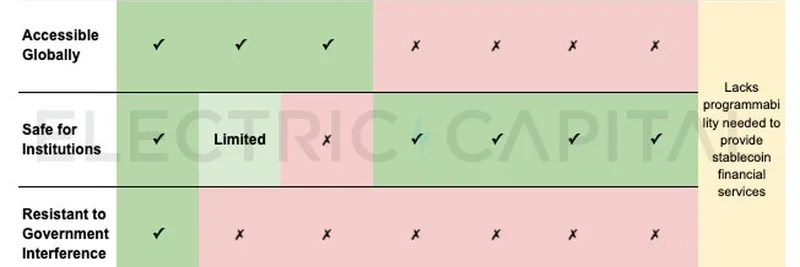Hey there, crypto enthusiasts! If you’ve been keeping an eye on the blockchain world, you’ve probably heard the buzz around Ethereum (ETH) lately. A recent thread by Maria Shen from Electric Capital on X (check it out here) dives deep into why Ethereum might just be the future of global finance. Let’s break it down in a way that’s easy to digest, even if you’re new to the space.
Ethereum’s Triple Threat: Accessibility, Safety, and Resistance
The tweet we’re focusing on includes a slick comparison chart that pits Ethereum against other blockchain platforms, traditional banking, and even corporate platforms like those offering stablecoin services. The key takeaway? Ethereum checks all three critical boxes that a global financial system needs:
Accessible Globally: With Ethereum, anyone with an internet connection can jump in 24/7, no matter where they are. Unlike traditional banking or centralized digital currencies (CBDCs), there’s no geographic gatekeeping. Solana and other blockchains also score here, but Ethereum’s ecosystem is more mature.
Safe for Institutions: This one’s a big deal. Institutions need security and regulatory clarity to play ball. Ethereum’s got over 10 years of uptime, a commodity status for ETH, and a robust Layer 2 (L2) stack that makes it customizable. Compare that to Bitcoin, which lacks the programmability needed for stablecoin financial services (unless the community agrees to a major upgrade), or corporate platforms that rely on intermediaries.
Resistant to Government Interference: Here’s where Ethereum shines with its decentralized nature. No single entity controls it, unlike CBDCs or traditional banking systems. Even Solana, while decentralized, doesn’t match Ethereum’s proven track record in this area.
The chart highlights that no other alternative meets all three requirements simultaneously. Bitcoin might catch up if it becomes more programmable (a big "if" depending on community consensus), but for now, Ethereum leads the pack.
Why This Matters for Stablecoins and Beyond
This discussion ties into the broader thread about stablecoins—digital dollars that don’t swing wildly in value like other cryptocurrencies. With stablecoins growing 60x since 2020 (as Maria notes), there’s a huge demand for a financial system that can handle them. Ethereum’s ability to support decentralized finance (DeFi) apps—like lending and yield farming—makes it the go-to platform. Traditional systems can’t scale globally or resist interference, while Ethereum’s open network does both.
What’s Next for Ethereum?
This thesis from Electric Capital suggests Ethereum isn’t just a platform—it’s becoming the backbone of a new financial world. With $140B+ in stablecoins and a thriving DeFi ecosystem, ETH is positioning itself as a reserve asset, much like gold or U.S. treasuries in traditional finance. The thread even hints at a flywheel effect: more stablecoin use drives more ETH demand, which boosts its value and security.
For meme token fans and blockchain practitioners, this is a goldmine of insight. While meme tokens like Dogecoin or Shiba Inu grab headlines, Ethereum’s infrastructure is what makes their ecosystems tick. If you’re building or investing, understanding this shift could give you an edge.
Final Thoughts
Ethereum’s unique combo of global access, institutional trust, and decentralization sets it apart in 2025. Whether you’re a crypto newbie or a seasoned pro, this Electric Capital thesis is worth a read (full piece here). Got questions or thoughts? Drop them in the comments—we’d love to chat!
Published on July 9, 2025, at 04:27 AM JST by Meme Insider


